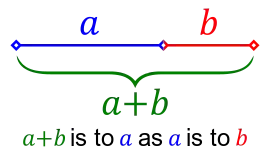More insight:
One way to consider the basic $x^2 - x - 1 = 0$ starting point in the above answer is to consider the initial golden ratio itself, i.e., $a + b$ is to $a$ as $a$ is to $b$,

or
\begin{align*}
\frac{a + b}{a} = \frac{a}{b} = \varphi.
\end{align*}
Now, if $b$ is of length $1$ and $a$ is $x$, we have $a + b = 1 + x$. Then we have
\begin{align*}
\frac{x + 1}{x} = \frac{x}{1} = \varphi
\end{align*}
so that
\begin{align}
x^2 - x - 1 = 0.
\end{align}
We then can plug this into the quadratic equation
\begin{align*}
\frac{-b \pm \sqrt{b^2 - 4ac}}{2a}
\end{align*}
which gives
\begin{align*}
\varphi = \frac{1 + \sqrt{5}}{2} = 1.6180339887498948482\dots
\end{align*}
but also
\begin{align*}
\varphi = \frac{1 - \sqrt{5}}{2} = -0.6180339887498948482\dots
\end{align*}
but since the golden ratio is the ratio of positives, we discard the second solution$-$initially, at least. See this for a use of the conjugate.
